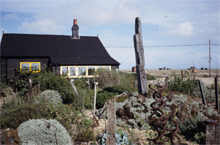HISTORY
Geology
The pattern of shingle ridges have built up at Dungeness over 5,000 years. The height of a shingle ridge can be used to determine the sea level at the time it was formed. Across Dungeness the ridges have been used to produce a series of records showing how sea level has changed naturally over the past 5,000 years.
Gravel extraction
Dungeness has attracted the gravel extraction industry for generations. Today, the legacy of this extraction can be seen in the number of gravel pits across the landscape. These pits are home to a plethora of wildlife from breeding seabirds, wintering wildfowl, to the rare great-crested newt and blood sucking medicinal leech.
Lydd Ranges
The vast Lydd Ranges have been owned by the Ministry of Defence since 1881, with the Royal Irish Rifles forming the first garrison there. The first permanent buildings were erected in 1906 in what are today very busy firing ranges stretching from Camber to near the power stations.
Lighthouse
There have been five lighthouses built at Dungeness over the centuries. Today, the Old Lighthouse which was built in 1904 still stands adjacent to the Round House, which once had a lighthouse on the top of it, the round house was built in 1792. The New Lighthouse (the stripy one) was built in 1961 to aid shipping further out to the Point. The New Lighthouse remains operational, while the Old Lighthouse is a tourist attraction.
Concrete Mirrors
At the back of two gravel pits at Lade on an island are the three concrete listening mirrors, built in the 1920’s and 1930’s to detect enemy aircraft as they approached Britain. This is the only site in Britain where all three designs are situated in one place. This early warning system with a range of 20 miles became obsolete by the outbreak of the Second World War. The site is now managed by the RSPB. Please see here for details of guided tours.
Houses
There are nearly 100 homes across the Dungeness Estate of many different shapes and sizes. Some near to the lighthouses originate from old railway carriages dragged across the shingle nearly one hundred years ago. Houses near to the Lifeboat Station are larger and are inhabited mainly by local fishermen, which are able to dry nets in the loft spaces.


